Dark web monitoring for business: the silent threat you’re not watching (yet)

When business owners hear the phrase “dark web,” they understand the nefarious reputation attached to this hub of anonymity. It’s a haven for hostile actors to connect with buyers of illegal goods, including your corporate information. The dark web is now a sophisticated marketplace that hides illicit activities and supplies cybercriminals with tools to disrupt your organization.
In the past 18 months alone, criminals attacked 72% of senior executives at least once. Without dark web monitoring for business, many organizations are operating blind against a major source of cyber risk. Your security team needs to respond faster or risk exposing your company to financial loss, reputational damage, and even regulatory penalties.
Continue reading this guide to explore the potential threats your business may face and the practical solutions to neutralize them before they escalate.
What is dark web monitoring for business, and why should you use it?
Most dark web users are there to secure tools or acquire stolen corporate information. Cybercriminals can accomplish their goals thanks to these hidden marketplaces. Dark web monitoring for business is a continuous effort where online tools scan and analyze these hidden parts of the internet.
You may be familiar with personal identity protection tools that monitor and flag credit card misuse or Social Security fraud. These services offer individuals credit alerts and identity theft recovery. Think of dark web monitoring as a digital security camera that scans the internet and alerts you to threats.
These tools allow cybersecurity teams to monitor encrypted forums, marketplaces, paste sites, and breach dumps for signs of stolen data. Imagine a copy of your company’s access keys, granting access to intellectual property or customer records, sold on the dark web.
Dark web monitoring for business focuses on preserving your business’s confidentiality by scanning hidden marketplaces. If threat actors acquire your sensitive data, they can:
- Hijack accounts, impersonate employees, or launch targeted attacks.
- Erode customer trust and disrupt operations.
- Start a broader campaign to expose data to fuel more targeted attacks.
Security teams use monitoring tools to discover vulnerable systems in your network. This way, they can quickly prevent catastrophic damage before it happens.
You may wonder how monitoring the dark web can be effective when its very nature allows criminals to remain anonymous. But this proactive measure is ideal for uncovering company vulnerabilities and implementing countermeasures. These tools use certain techniques to detect dark web threats and alert your organization.
Scanning dark web locations for leaked credentials
A business uses online tools to search the dark web for any information relevant to leaked employee login details. Early detection means an opportunity to begin prompt password resets and reinforce authentication protocols to stop unauthorized access.
Watching criminal marketplaces
A security team actively monitors underground forums or marketplaces where they suspect criminals exchange stolen data, cyberattack strategies, and hacking tools. Your organization can discover chatter about a newly developed phishing kit targeting your platform. Instead of damage control, your team could update its security measures and educate employees and clients about the potential threat.
Gathering threat intelligence
Dark web threat intelligence is a process of identifying and verifying information about emerging threats and criminal tactics. Consider a breach of sensitive customer information at an ecommerce company. Their security team uncovers intelligence in a dark web forum that reveals a surge in stolen credit card information. Analyzing the data allows this brand to find flaws in its fraud detection systems and strengthen its website’s transaction security.
Understanding business risk
Businesses need fast and intentional response efforts when dealing with their security vulnerabilities. When dark web threats go undetected, the consequences can escalate quickly, disrupting business-critical functions. In healthcare, leaked patient records can lead to medical identity theft, HIPAA violations, and lawsuits.
In finance, exposed customer data can lead to wire fraud and FDIC or SEC penalties. Beyond direct losses, companies face reputational damage, extended response costs, and operational downtime that can halt service delivery.
Dark web monitoring for business brings these risks to the surface earlier through keyword tracking, web crawling, community monitoring, and AI-driven pattern recognition. A hybrid approach blends automation with human analysis so high-risk exposures don’t slip through the cracks.
To learn more, we invite you to check out our blog on dark web monitoring.
Why is dark web monitoring important for enterprises?
The harsh reality is even with strong internal practices, criminals can still expose your information. A single reused password or third-party breach can unlock sensitive systems. Dark web monitoring tools strengthen defenses by adding another layer of protection for your digital vulnerabilities.
Speed is the only real advantage. Here’s how fast action stops dark web threats from escalating.
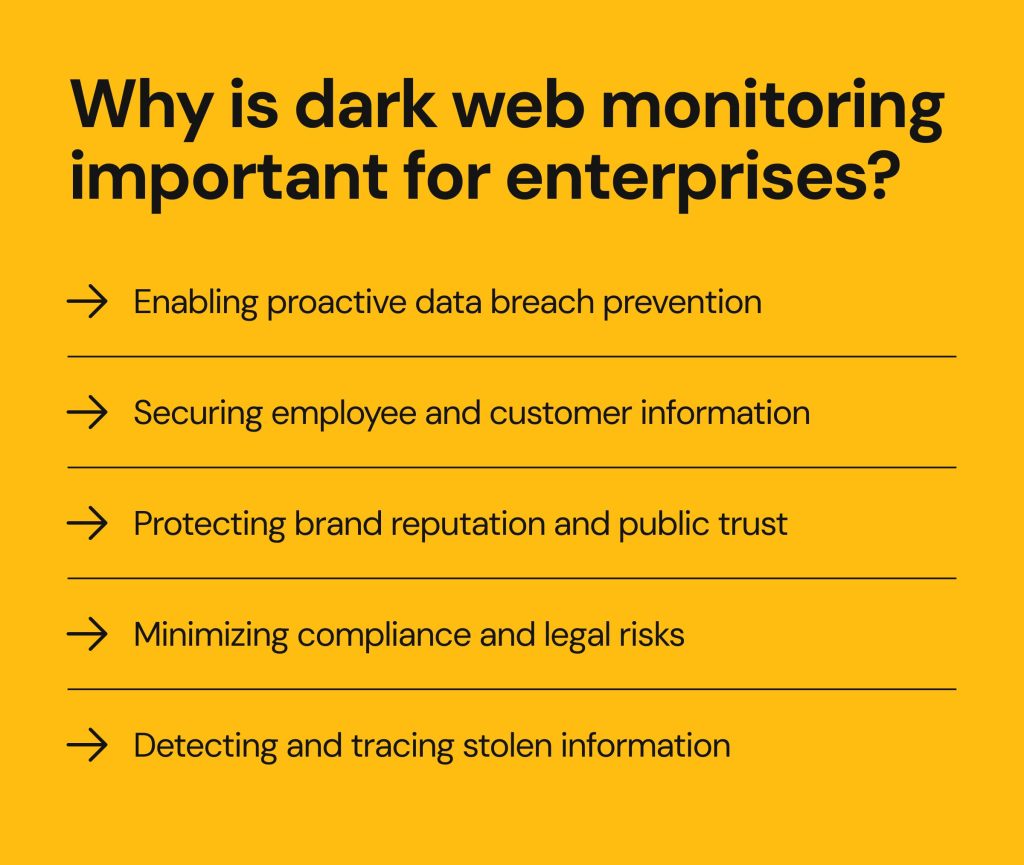
Be proactive and prevent data breaches with enterprise dark web monitoring
Dark web monitoring supports a proactive security strategy and identifies exposures before criminals exploit them. In contrast, reactive approaches tend to detect threats only after the damage is underway, which leads to delayed containment and increased exposure.
Enterprise dark web monitoring enables earlier detection and gives the company more control over the situation. They can tighten internal security and take legal action before data loss transforms into operational fallout and long-term financial risk.
Global cybercrime is projected to cost $10.5 trillion in 2025, up from $3 trillion in 2015, a clear indicator that prioritizing early detection and preventative measures is no longer optional.
Protect employee and customer information from malicious individuals
Dark web monitoring for business prevents threat actors from weaponizing sensitive employee and customer data. Cybercriminals consider names, login credentials, email addresses, Social Security numbers, and payroll details high-value targets.
A hybrid monitoring approach that combines automated scans with human analysis means security teams can immediately reset access, notify those affected, offer credit monitoring, and strengthen system protections. A proactive company builds trust with employees and customers and actively demonstrates accountability.
By contrast, a delayed response often leads to media exposure and reputational damage.
Uphold your brand’s reputation and strengthen public trust
Even when criminals don’t immediately exploit your exposed data, the negative attention is enough to erode trust and spread to the media, competitors, customers, and investors. The 2017 Equifax data breach is a well-known case that compromised roughly 147 million customers’ personal information.
It led to a $700 million settlement and long-term reputational fallout. Yet, businesses that act early can change the narrative. A recent data breach in late 2024, involving Hertz’s third-party vendor, Cleo Communications, compromised customer data.
Once confirmed, Hertz quickly engaged cybersecurity experts, notified the affected, and offered two years of free identity monitoring services. The company also reported the incident to the authorities. Hertz’s commitment to transparency and security demonstrates leadership and a clear commitment to those they serve.
Lower your exposure to compliance and legal risks
An exposure of sensitive data is bad enough, but the legal consequences can be catastrophic. Beyond eroding customer and employee trust in your brand, a breach could trigger audits, lawsuits, or penalties from HIPAA or the FTC. Dark web security monitoring supports compliance readiness by contributing to faster detection, quicker notifications, and more documented response protocols.
Still, dark web monitoring is only part of a broader data protection strategy. These activities demonstrate accountability to regulators, and incorporating these tools shows a company is doing its due diligence and has taken reasonable steps to protect sensitive information.
Find evidence of stolen information
Dark web security monitoring uncovers high-impact blind spots that traditional security tools often miss, like stolen admin credentials or sensitive IP quietly circulating on underground forums. These exposures can give attackers privileged access long before your team detects a breach.
For example, corporate login credentials tied to a company domain may be posted for sale online, enabling bad actors to bypass security controls and get access to cloud platforms, internal systems, or customer data. Many ransomware attacks start this way, not with brute-force, but with a simple login.
Intellectual property is also a frequent target. If a product designs leak from a compromised developer environment, they often surface on a dark web marketplace. When the company discovers the breach, cybercriminals, competitors, or nation-state actors may have already exploited the stolen data. Its competitive edge, operational security, and viability are at serious risk.
That’s why dark web monitoring is essential for containing exposures and safeguarding brand value.
Top dark web monitoring solutions for businesses
As dark web threats grow more sophisticated, businesses need visibility before risks escalate into full-scale breaches. The comparison table below outlines five leading monitoring solutions designed to help organizations detect, respond to, and mitigate dark web threats.
| Dark Web Tool | Main Strengths | Technical Focus | Best For | Drawback |
|---|---|---|---|---|
| ZeroFox | Broad digital risk protection, AI-driven threat intelligence, strong brand impersonation monitoring | AI-driven threat detection across the dark web | Enterprises needing wide brand, executive, and domain protection | May be overkill for small companies without digital brand risks |
| CrowdStrike Falcon Intelligence | Deep adversary intelligence, automated credential remediation, integrated threat actor profiling | Threat actor profiling + automated credential response | Enterprises with Falcon platforms, critical infrastructure sectors | High cost; strongest when paired with the broader Falcon suite |
| Rapid7 Threat Command | Easy-to-use dashboard, real-time external threat alerts, contextual risk scoring for faster prioritization | Dark web surveillance + contextual risk scoring | Mid-to-large businesses needing efficient threat prioritization | Less focus on deep human threat actor analysis |
| SpyCloud | Credential recovery at scale, malware stealer intelligence, automated remediation workflows | Stolen credentials, session cookies, malware-infected data recovery | Identity-focused businesses (finance, healthcare, e-commerce) | Focused mostly on identity exposure, not wider threat ops |
| Recorded Future | High-fidelity threat enrichment, AI + human intelligence, proactive geopolitical + cybercrime early warnings | AI + human analyst correlation of dark web findings | Enterprises needing proactive geopolitical/cybercrime early warnings | May be too expansive for teams without dedicated threat analysts |
ZeroFox
ZeroFox is a platform built to provide real-time dark web threat intelligence tailored for companies with a broader, high-impact digital footprint. It scans the deep and dark web to identify exposed credentials, impersonation attempts, and brand risks. ZeroFox bolsters cybersecurity resilience for enterprises, particularly vulnerable to social media impersonation and large-scale data leaks.
Thanks to its AI-driven threat detection, exhaustive coverage of threat surfaces, and strong SIEM/SOAR integration, it’s scalable and efficient for businesses locked in for high-growth.
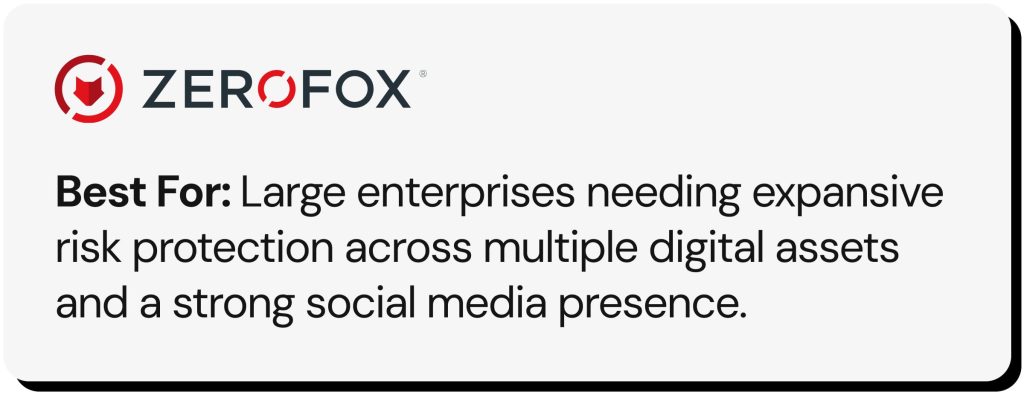
CrowdStrike Falcon Intelligence
CrowdStrike Falcon Intelligence delivers insights as part of its larger dark web threat intelligence ecosystem. It goes beyond basic monitoring by profiling threat actors, identifying signs of stolen credentials, and triggering automated responses within the broader Falcon platform. With adversary tracking, automated account protection, and deep integrations with existing security tools, Falcon Intelligence is a potent solution for companies with complex security operations.
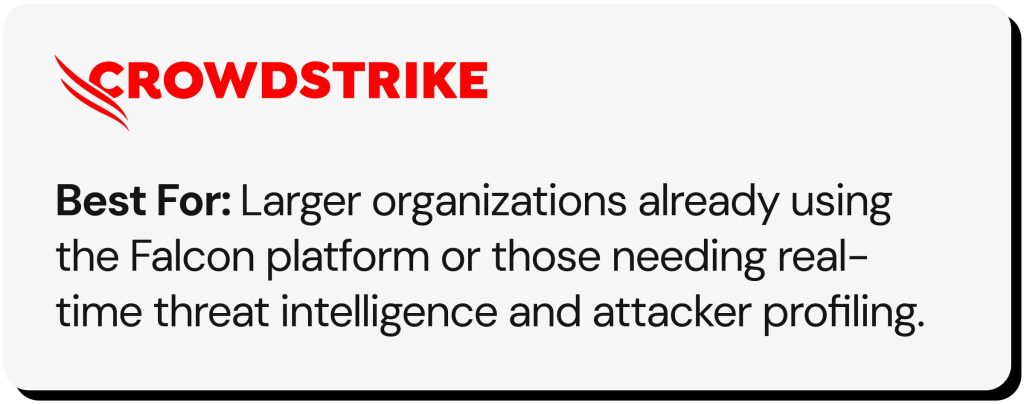
Rapid7 Threat Command
Rapid7’s Threat Command proactively monitors external threats, focusing on agility and usability to offer dark web surveillance without overwhelming teams with noise. The system delivers contextual alerts based on security relevance and threat severity. With features like real-time threat alerts, dark web surveillance, and contextual intelligence, security teams can prioritize threats and act faster.
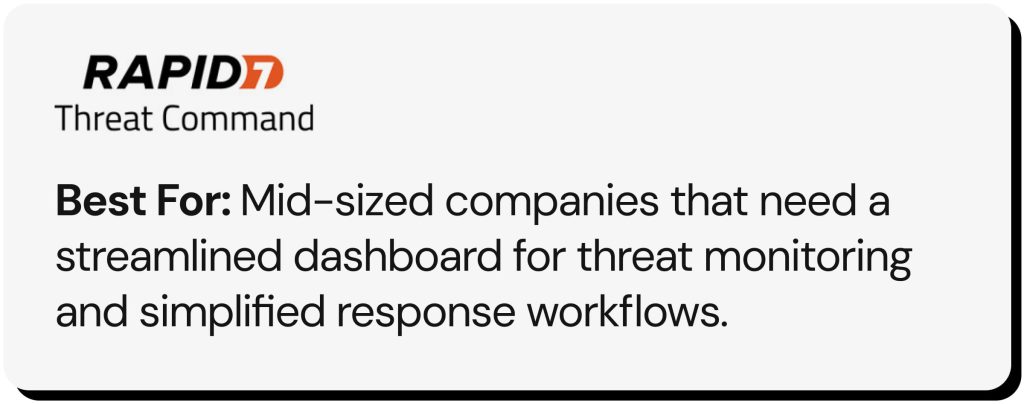
SpyCloud
SpyCloud is a product that focuses on detecting identity-driven threats and recovering stolen credentials and malware-compromised data before criminals can use them. It can map breach data back to specific employees, vendors, or customers, which triggers automated solutions using IAM and fraud prevention systems. With features such as malware stealer intelligence, automated response workflows, and credential recovery, SpyCloud is a go-to for identity security.

Recorded Future
Another AI-powered threat intelligence platform that provides a threat picture with its “See It First, See The Most” defense system. Recorded Future combines dark web intelligence with human-led analysis to provide security personnel with enriched, high-priority insights from monitoring ransomware forums, leak sites, and criminal marketplaces. With continuous dark web scanning, AI and human enrichment, and prioritized threat scoring, teams can assess threats based on risk and relevance for faster and more confident action.
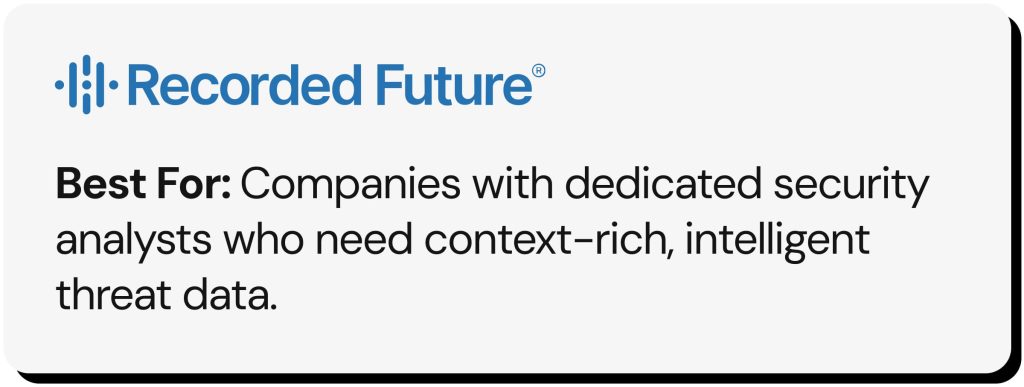
How to implement dark web monitoring in your organization
Monitoring the dark web will only ever be as effective as the strategy you use to support it. It’s not enough to choose the right tool–you must also build a vigilant culture across your company to drive action.
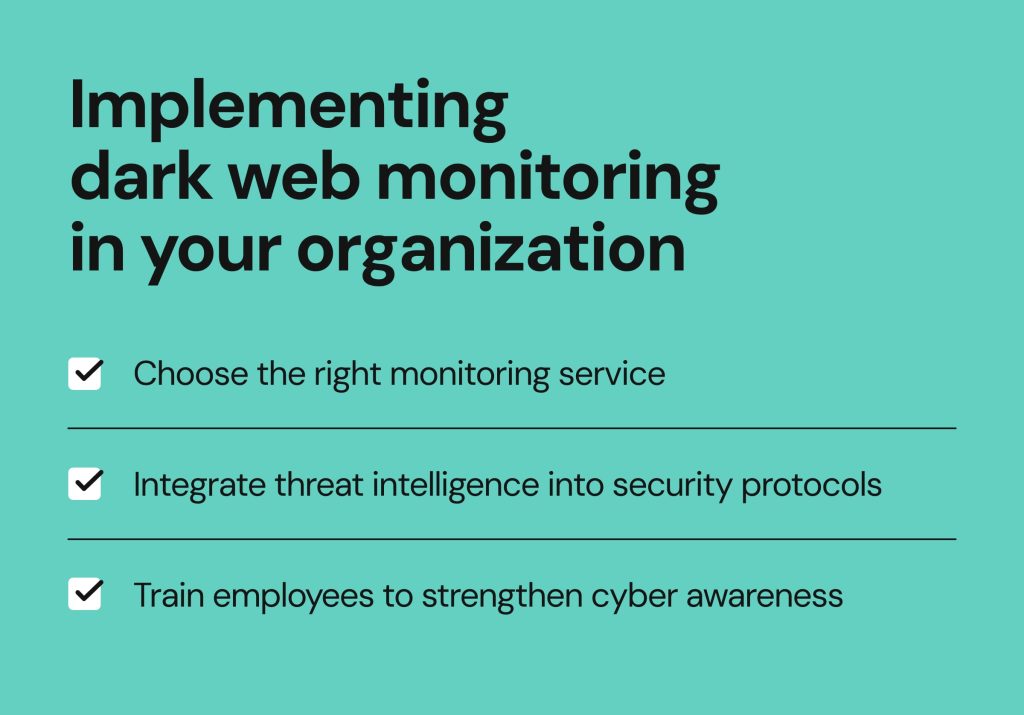
Choosing the right monitoring service
Choosing the wrong solution from a list of dark web monitoring companies could mean poor threat visibility and costly response gaps. You should evaluate a platform based on how it aligns with your organization’s size, risk profile, and technical maturity. In other words, consider how your internal resources, existing security tools, and overall security readiness affect your ability to act on threat intelligence.
For small businesses, consumer-oriented platforms like LastPass or Norton can be a practical starting point. Consumers get basic credential monitoring and breach alerts at a manageable cost, which helps lean teams respond to threats quickly. Larger organizations managing thousands of user accounts face a different risk level.
They require advanced platforms like ZeroFox or CrowdStrike because of their deeper intelligence capabilities, integrations, and faster incident response. When evaluating vendors, look for solutions that provide:
- Real-time alerts that uncover threats before they escalate
- User-friendly dashboards with context, not just notifications
- Comprehensive dark web coverage across forums, marketplaces, ransomware sites, and stealer logs
- SIEM or SOAR integrations for automated investigations and breach responses
The goal is to invest in a platform that delivers structured, actionable intelligence that fits seamlessly into your existing tech stack and operational tempo.
Integrating threat intelligence into security protocols
Integrate dark web monitoring data into your security operations, not as a separate layer, but as a fully embedded part of your detection and response ecosystem. Effective products can automatically route threat alerts into workflows that trigger password reset protocols when exposed, and enrich ongoing threat hunts using signals from dark web chatter.
Automation allows monitoring tools to connect with SIEMs, IAM systems, and incident response playbooks, which enables organizations to dramatically cut their manual response time. Success means reducing exposure from days to minutes with defensive actions that protect brand integrity.
Employee awareness and cybersecurity training
Technology by itself cannot close the gap. Effective dark web monitoring depends on people knowing how to respond to data exposure. Security training should utilize real-world examples of stolen credentials, clear instructions for reporting suspicious activity, and guidance on recognizing the early signs of compromised security.
Reinforcing strong password practices, multi-factor authentication, or agile responses to credential resets can build solid habits to support your defenses. With these measures, security becomes more than a system, it’s a shared responsibility.
Dark web monitoring tools empower teams to protect the trust that keeps them resilient. Building a security-aware culture doesn’t just make sense. It’s a competitive advantage in a threat landscape where speed, clarity, and coordination can make all the difference.
FAQs
How can dark web monitoring protect a business?
Dark web monitoring protects a business by detecting stolen credentials, sensitive documents, or insider leaks before attackers can exploit them. Effective intelligence gathering from underground sources means companies gain early warning signals that support faster investigations, account resets, and breach containment. Overall, this prevents operational disruptions and brand damage.
What are the best dark web monitoring companies for enterprises?
Leading enterprise solutions include ZeroFox, CrowdStrike, and Rapid7. These platforms offer companies deep and dark web surveillance, threat actor profiling, credential recovery, and easy integration with SIEM or SOAR tools. These solutions support a proactive defense system that improves detection speed and cyber resilience.
Can small businesses benefit from dark web monitoring?
Absolutely. Small businesses are frequent targets for criminals who assume they have limited defenses. Dark web monitoring offers small teams the visibility to combat credential theft and leaked customer information. These tools also reduce the chance of account takeovers or fraud.

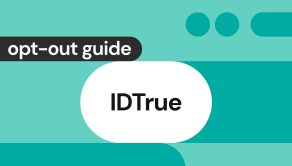



Dimitri is a tech entrepreneur and founder of Onerep, the first fully automated data removal service. Top cybersecurity CEO of 2021 by The Software Report.